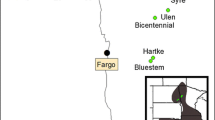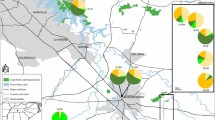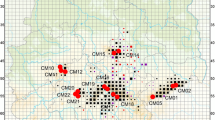Abstract
Federally endangered Xyris tennesseensis is a perennial monocot found in imperiled wetlands such as calcareous seeps and riparian habitats within its disjunct distribution (one county in Tennessee, three in Alabama and four in Georgia). This species belongs to a genus of wetland plants for which very little genetic work has been carried out. Because of the rarity of this species, we hypothesized that it would have low genetic variability overall and that populations were likely to be genetically differentiated due to the species’ disjunct distribution. Fourteen microsatellite loci polymorphic at the species level showed limited variability at the population level, averaging 16.3% polymorphic loci, 1.17 alleles per locus, an observed heterozygosity of 0.017, and an expected heterozygosity of 0.054. The discrepancy between observed and expected heterozygosity resulted in a relatively high FIS of 0.71, suggesting that X. tennesseensis experiences high levels of inbreeding. We also found evidence of varying levels of vegetative reproduction in this species. Analysis of molecular variance estimated that differentiation among the regions (states) accounted for the majority (60%) of the genetic variation in this species, with an additional 31% due to genetic differences among the populations of each state and only 9% due to variability within populations. These data indicate X. tennesseensis possesses low levels of genetic diversity and experiences virtually no gene flow among populations. To preserve the genetic diversity of this species, multiple populations must be protected, with priority given to the largest and most variable populations in each region.



Similar content being viewed by others
References
Aavik T, Talve T, Thetloff M, Uuemaa E, Oja T (2017) Genetic consequences of landscape change for rare endemic plants—a case study of Rhinanthus osiliensis. Biol Conserv 210:125–135
Andrés JA, Bogdanowicz SM (2011) Isolating microsatellite loci: looking back, looking ahead. Mol Methods Evol Genet 722:211–232
Balloux F, Lehmann L, de Meeus T (2003) The population genetics of clonal and partially clonal diploids. Genetics 164:1635–1644
Barrett SCH, Kohn JR (1991) Genetic and evolutionary consequences of small population size in plants: implications for conservation. In: Falk DA, Holsinger KE (eds) Genetics and conservation of rare plants. Oxford University, New York, pp 3–30
Baskauf CJ, Jinks NC, Mandel JR, McCauley DE (2014) Population genetics of Braun's Rockcress (Boechera perstellata, Brassicaceae), an endangered plant with a disjunct distribution. J Hered 104:124–137. https://doi.org/10.1093/jhered/est074
Baskin CC, Baskin JM (2003) Seed germination and propagation of Xyris tennesseensis, a federal endangered wetland species. Wetlands 23:116–124
Beardmore JA (1983) Extinction, survival, and genetic variation. In: Schoenmwald-Cox CM, Chambers SM, MacBryde B, Thomas L (eds) Genetics and conservation. Benjamin-Cummings, Menlo Park, pp 125–151
Boyd RS, Moffett JM (2010) Population survey of the federally endangered Tennessee Yellow-Eyed Grass (Xyris tennesseensis). Unpublished report to the U.S. Fish and Wildlife Service, Jackson, MS, pp 13
Boyd RS, Teem A, Wall MA (2011) Floral biology of an Alabama population of the federally endangered plant, Xyris tennesseensis Kral (Xyridaceae). BioONE 76:255–326
Cole CT (2003) Genetic variation in rare and common plants. Annu Rev Eco Evo Syst 34:213–237
Earl DA, vonHoldt BM (2012) STRUCTURE HARVESTER: a website and program for visualizing STRUCTURE output and implementing the Evanno method. Conserv Genet Res 4:359–361
Ellis JR, Pashley CH, Burke JM, McCauley DE (2006) High genetic diversity in a rare and endangered sunflower as compared to a common congener. Mol Ecol 15:2345–2355
Ellstrand NC, Elam DR (1993) Population genetic consequences of small population size: implications for plant conservation. Annu Rev Ecol Syst 24:217–242
Evanno G, Regnaut S, Goudet J (2005) Detecting the number of clusters of individuals using the software STRUCTURE: a simulation study. Mol Ecol 14:2611–2620
Faircloth BC (2008) Msatcommander: detection of microsatellite repeat arrays and automated, locus-specific primer design. Mol Ecol Res 8:92–94
Frankham R (1995) Conservation genetics. Annu Rev Genet 29:305–320
Gathmann A, Tscharntke T (2002) Foraging ranges of solitary bees. J Anim Ecol 71:757–764
Gitzendanner MA, Soltis PS (2000) Patterns of genetic variation in rare and widespread plant congeners. Am J Bot 87:783–792
Halkett F, Simon JC, Balloux F (2005) Tackling the population genetics of clonal and partially clonal organisms. Trends Ecol Evol 20:194–201
Hamrick JL, Godt MJW (1989) Allozyme diversity in plant species. In: Brown ADG, Clegg MT, Kahler AL, Weir BS (eds) Plant population genetics, breeding, and genetic resources. Sinauer Associates Publishing, Massachusetts, pp 43–63
Hamrick JL, Godt MJW (1996) Effects of life history traits on genetic diversity in plant species. Philos Trans R Soc London [Biol] 351:1291–1298
Hartl DL, Clark AG (2007) Principles of population genetics. Sinauer Associate, Massachusetts
Hatmaker EA, Staton ME, Dattilo AJ, Hadziabdic D, Rinehart TA, Schilling EE, Trigiano RN, Wadl PA (2018) Population structure and genetic diversity within the endangered species Pityopsis ruthii (Asteraceae). Front in Plant Sci. https://doi.org/10.3389/fpls.2018.00943
Holm S (1979) A simple sequentially rejective multiple test procedure. Scand J Stat 6:65–70
Huennke LF (1991) Ecological implications of genetic variation in plant populations. In: Falk DA, Holsinger KE (eds) Genetics and conservation of rare plants. Oxford University, New York, pp 31–44
Jakobsson M, Rosenberg NA (2007) CLUMPP: a cluster matching and permutation program for dealing with label switching and multimodality in analysis of population structure. Bioinformatics 23:1801–1806
Jimenez A, Mansour H, Keller B, Conti E (2014) Low genetic diversity and high levels of inbreeding in the Sinai primrose (Primula boveana), a species on the brink of extinction. Plant Syst Evol 300:119–1208
Johnson T, Kruse-Sanders JM, Pullman GS (2012) Micropropagation and seed cryopreservation of the critically endangered species Tennessee yellow-eye grass, Xyris tennesseensis Kral. In Vitro Cell Dev Biol Plant 48:369–376
Kral R (1983) The Xyridaceae in the southeastern United States. J Arnold Arboretum 64:421–429
Kral R (1990) A status report on Xyris tennesseensis. Unpublished report submitted to U.S. Fish and Wildlife Service, Jackson, Mississippi, pp 22
Kral R (2000) Xyris. In: Flora of North America Editorial Committee (ed) Flora of North America North of Mexico. Oxford University, New York, pp 154–167
Luikart G, Allendorf FW, Sherwin B, Cornuet JM (1998) Distortion of allele frequency distributions provides a test for recent population bottlenecks. J Hered 12:238–247
Meirmans PG (2006) Using the AMOVA framework to estimate a standardized genetic differentiation measure. Evolution 60:2399–2402
Meirmans PG, Hedrick PW (2011) Assessing population structure: FST and related measures. Mol Ecol Res 11:5–18
Meirmans PG, Van Tienderen PH (2004) GENOTYPE and GENODIVE: two programs for the analysis of genetic diversity of asexual organisms. Mol Ecol Notes 4:792–794
Moffett JM Jr (2008) Xyris tennesseensis: status survey, habitat restoration/management concerns, and relation to a new Xyrid, Xyris spathifolia. Ph.D. dissertation, Auburn University, Auburn, AL
Moffett JM, Boyd RS (2013) Management of a population of the federally endangered Xyris tennesseensis (Tennessee Yellow-Eyed Grass). Castanea 78:198–212
Nei M (1978) Estimation of average heterozygosity and genetic distance from a small number of individuals. Genetics 89:583–590
Nybom H (2004) Comparison of different nuclear DNA markers for estimating intraspecific genetic diversity in plants. Mol Ecol 13:1143–1155
Peakall R, Smouse PE (2012) GENALEX 6.5: genetic analysis in Excel. Population genetic software for teaching and research-an update. Bioinformatics 28:2537–2539
Peakall R, Ebert D, Scott LJ, Meagher PF, Offord CA (2003) Comparative genetic study confirms exceptionally low genetic variation in the ancient and endangered relictual conifer, Wollemia nobilis (Araucariaceae). Mol Ecol 12:2331–2343
Piry S, Luikart G, Cornuet JM (1999) Bottleneck: a computer program for detecting recent reductions in the effective population size using allele frequency data. J Hered 90:502–503
Pritchard JK, Stephens M, Donnelly P (2000) Inference of population structure using multilocus genotype data. Genetics 155:945–959
Ramasamy RK, Ramasamy S, Bindroo BB, Naik VG (2014) STRUCTURE PLOT: a program for drawing elegant STRUCTURE bar plots in user friendly interface. Springerplus 3:431
Reed DH, Frankham R (2003) Correlation between fitness and genetic diversity. Conserv Biol 17:230–237
Rousset F (2008) Genepop’007: a complete reimplementation of the Genepop software for Windows and Linux. Mol Ecol Res 8:103–106
Rozen S, Skaletsky H (1999) Primer3 on the WWW for general users and for biologist programmers. Bioinformatics methods and protocols. Humana Press, Totowa, NJ, pp 365–386
Schuelke M (2000) An economic method for the fluorescent labeling of PCR fragments. Nat Biotechnol 18:233–234
Simmons L (2018) Genetic diversity of endangered orchid Phaius australis across a fragmented Australian landscape. Conserv Genet 19:451–465
Sloop CM, Pickens C, Gordon SP (2011) Conservation genetics of Butte County meadowfoam (Limnanthes floccose ssp. Californica Arroyo), an endangered vernal pool endemic. Conserv Genet 12:311–323
Sloop CM, Eberl R, Ayres DR (2012) Genetic diversity and structure in the annual vernal pool endemic Limnanthis vinculans Ornduff (Limnanthaceae): implications of breeding system and restoration practices. Conserv Genet 13:1365–1379
U.S. Fish and Wildlife Service (1991) Endangered and threatened wildlife plants; endangered status for the plant Xyris tennesseensis (Tennessee yellow-eyed grass). Fed Reg 56:34151–34154
U.S. Fish and Wildlife Service (1994) Recovery plan for tennessee yellow-eyed grass (Xyris tennesseensis Kral). MS, Jackson, p 24
Wall MA, Teem AP, Boyd RS (2002) Floral manipulation by Lasioglossum zephyrum (Hymenoptera: Halictidae) ensures first access to floral rewards by initiating premature anthesis of Xyris tennesseensis (Xyridaceae) flowers. Fla Entomol 85:290–291
Weir BS, Cockerham CC (1984) Estimating F-statistics for the analysis of population structre. Evolution 38:1358–1370
Acknowledgements
Funding was provided in part by grants to CJB from the U.S. Fish and Wildlife Service Cooperative Endangered Species Conservation Fund, and Austin Peay State University’s Scholarly and Creative Fellowship Program. We thank the many people who helped us find and access X. tennesseensis sites: M. Hardig, S. Baskauf, M. Brock, and staff from TDEC (A. Bishop), Georgia Department of Natural Resources (M. Moffett), Fort McClellan Army National Guard Training Center in AL (L. Storino, J. Ratcliffe), and US Fish and Wildlife Service (G. Call, S. Holbrook). Thanks also to N. Willis, R. Hankenson, and S. Settle for aid in sample collection, and N. Bannis for aid in sample processing.
Author information
Authors and Affiliations
Corresponding author
Additional information
Publisher's Note
Springer Nature remains neutral with regard to jurisdictional claims in published maps and institutional affiliations.
Electronic supplementary material
Below is the link to the electronic supplementary material.
Rights and permissions
About this article
Cite this article
Downey, K.M., Baskauf, C.J. Population genetics of a rare wetland species, the Tennessee yellow-eyed grass (Xyris tennesseensis, Xyridaceae). Conserv Genet 21, 735–746 (2020). https://doi.org/10.1007/s10592-020-01285-3
Received:
Accepted:
Published:
Issue Date:
DOI: https://doi.org/10.1007/s10592-020-01285-3




